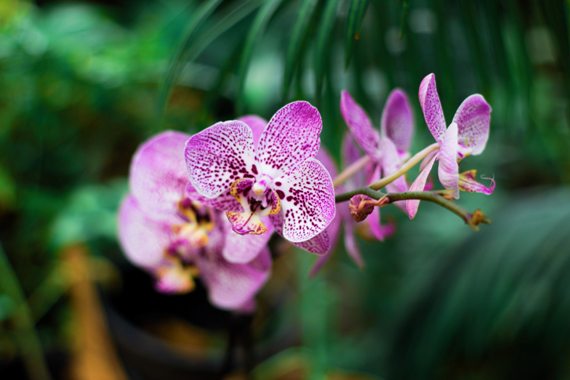There are many types of orchid diseases, but this list was put together to highlight some of the more common types of orchid diseases and how to identify, treat and ultimately prevent. Orchids get a bad rap for being tough to take care of. When in all reality they are quite easy to care for, if the orchid owner is patient and diligent.

There are three topics that are common with orchid ailments and they include burns, rots and pests. These are usually where you want to start. The next step is to identify which ailment your orchid is suffering from and for that we’ll talk about identification of the specific problem and what to look for. Lastly, we will talk about how you can treat and prevent those problems in the future.
Burns
You basically have three types of burn with orchids and those are sunburn, fertilizer burn and freezer burn. All three have relatively simple prevention methods, but it some cases it might take a little time for your orchid to heal. So, make sure that you’re patient and don’t try to rush things.
Sunburn Identification
This typically happens with orchids that are either moved to new window in the house or put outside in the warmer months. The affected portion looks like a thin light patch with a dark ring. It can be present with a single sunspot or multiple tiny sunspots.
Sunburn Treatment
Obviously, the first thing that you want to do is to decrease the light that your orchid is receiving. Usually the best thing to do with sunburn is to leave it untreated and let the orchid naturally heal itself. You want to check to make sure the damaged portion stays dry. If so, then you are fine and the orchid leaf is still providing nourishment to the overall plant. In some cases the wound will turn mushy and start to rot. If that is your situation, you’ll have to follow the rot treatment explained below.
Sunburn Prevention
Make sure to acclimate orchids slowly to new light conditions. Understand that different seasons produce different levels of light and adjust to those conditions. Generally, orchids are not a heavy light requiring plant and more often than not beginners feel like their orchids are not receiving enough light. So, they drastically increase light conditions and this is when Sunburn can happen.
Fertilizer Burn
This is another very common problem with new orchid growers. People feel that more is usually better and they will get quicker results from over feeding their orchids. Again, this is where the patience comes into play. Be careful to make sure that you’re not over fertilizing your orchids, if left untreated it can ultimately kill the plant.
Fertilizer Burn Identification
Some common things that you will see when you are over feeding your orchids are: lack of root growth, salt build up on potting medium, dead root tips, salt build up on pot and brownish black dead leaf tips.
Fertilizer Burn Treatment
Basically if you start to see these symptoms you’re going to have to do an emergency repot. You want to remove the entire old medium as well obtain a new pot. Thoroughly rinse all salt build up off of the orchid and repot it with new medium and watch closely for a couple weeks.
Fertilizer Burn Prevention
There are a couple things that you can do to prevent this from happening, but the main thing is that you want to avoid over fertilizing your plant. The rule of thumb is to usually cut the recommended dosage in half and gradually move it up if necessary. Another thing you can do is to make sure that you give your orchid a nice rinse with plain fresh water including the medium and root areas after fertilizing.
Freezing
In some cases people don’t give their orchids the correct temperature that they need to survive. The problem with orchids that have cold damage is that they often don’t really show signs until they are moved to warmer temperatures. Most of the time if you’re between 65 and 80 degrees you should be OK.
Freezing Identification
Some things to look for if you suspect the orchid has any type of freeze damage are: browning, surface wounds, sunken discolored spots, slowed growth and accelerated rate of death.
Freezing Treatment
Make sure you allow the medium to dry completely and keep orchids in a humid, low light environment. Don’t let affected orchids have direct sunlight or expose them to extremely high temperatures. Again, be gradual with treatment and be patient to let the orchid heal itself. It’s like caring for someone with a cold. Just watch them and prevent them from getting worse.
Freezing Prevention
This is a tough one but try to keep your orchids in temperatures from 65 – 80 degrees Fahrenheit (depending on the need of the specific orchid).
Rots
Rots are extremely common and very deadly to orchids because they can spread from one orchid to another quite easily. With most rot problems the culprit is usually overwatering. We’ll talk about a couple types of rot and the first being Black Rot.
Black Rot
Black rot is pretty severe and if left untreated will ultimately kill the plant. The real problem with black rot is that if you’re watering an orchid with black rot and you have other orchids nearby, the splash back can get on those other orchids and ultimately infect them as well.
Black Rot Identification
If you have massive black spots overtaking entire leaves you may have black rot. You can’t mistake the very dark color and it will usually be accompanied with a yellow margin around the edges. It can affect any part of the orchid, but usually starts with the edges of new leaves and works its way down to the roots.
Black Rot Treatment
The first thing you must do is quarantine the infected orchid away from any other plants. Once that is done, you’ll want to increase air circulation on the affected orchid. Raise the orchid off the ground to avoid any type of splash back. Use a sterile razor blade and cut well below the affected area. Allow the cut to dry and apply a fungicide to the cut area. You can use cinnamon combined with cooking oil to create a homemade fungicide paste that works quite well.
Root Rot
Another type of rot that is common with orchids is root rot. This happens often with new orchid growers due to overwatering. It occurs when the medium is broken down and the drainage is poor. This can kill your orchid if left untreated.
Root Rot Symptoms
You’ll first probably notice symptoms of root rot on other parts of the orchid. Leaves can become twisted, thin, and shriveled. The roots will be mushy, limp, and dead.
Root Rot Treatment
If you suspect that your orchid has root rot you’ll definitely want to repot with a new substantial medium. But first, you’ll want to remove affected areas with a sterile razor blade. Remove both affected roots and leaves. Apply a fungicide to cut areas.
Root Rot Prevention
Whenever you get a new orchid it’s a good idea to repot it right away to check roots. Often, there will be a couple of dead roots and catching them early is really the way to go. Really, the most common reason for root rot is over watering. Remember if you’re not sure if your orchid needs water, wait another day or two. It’s always better for orchids to be on the dry side as opposed to being damp.
Related Articles & Free Email Newsletter
Inaccurate Objections to Semi-Hydroponics Culture
Orchid Light Level Recommendations
Subscribe to our Free Email Newsletter
Background Information for this Article was Provided by EzineArticles.com




Comment here